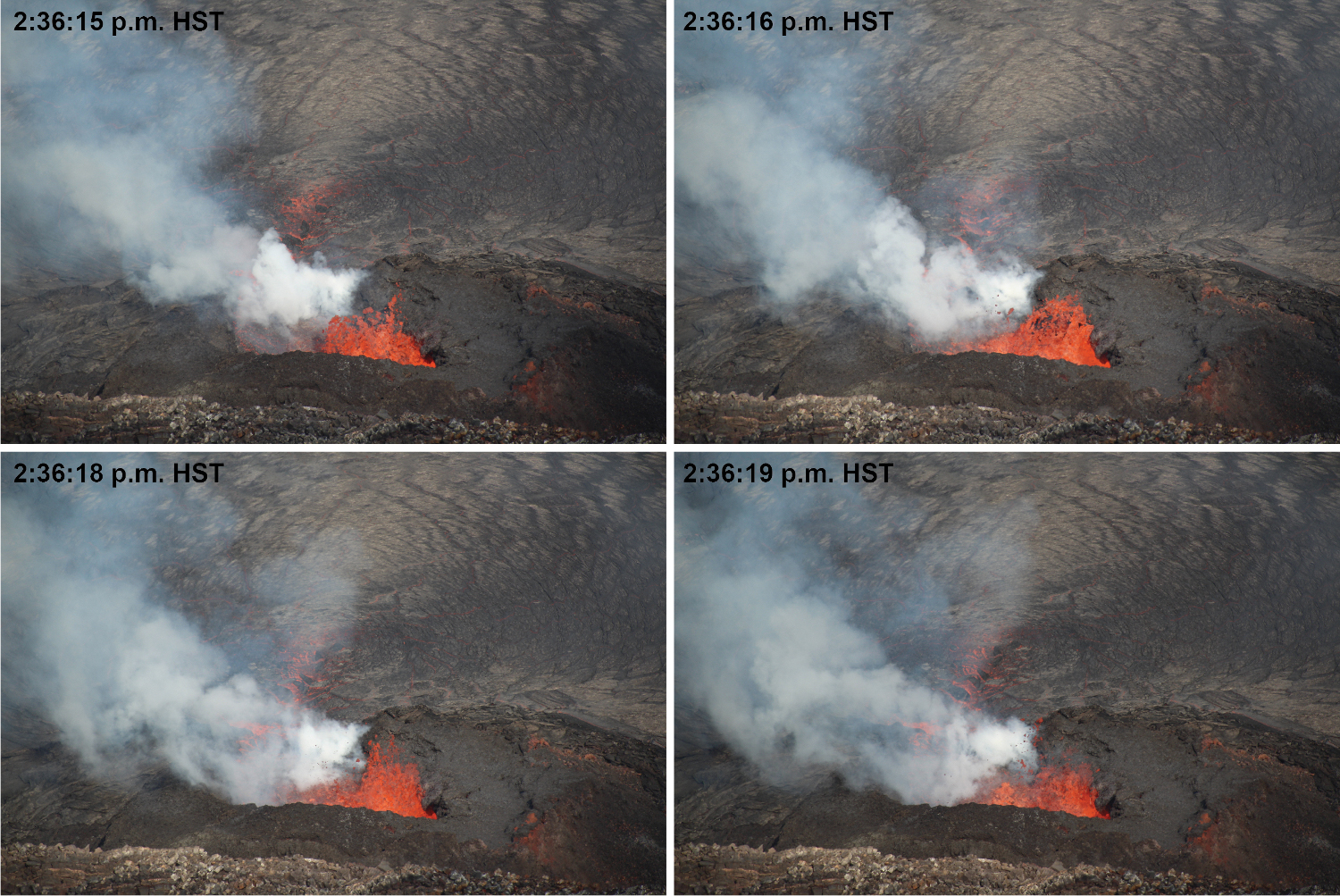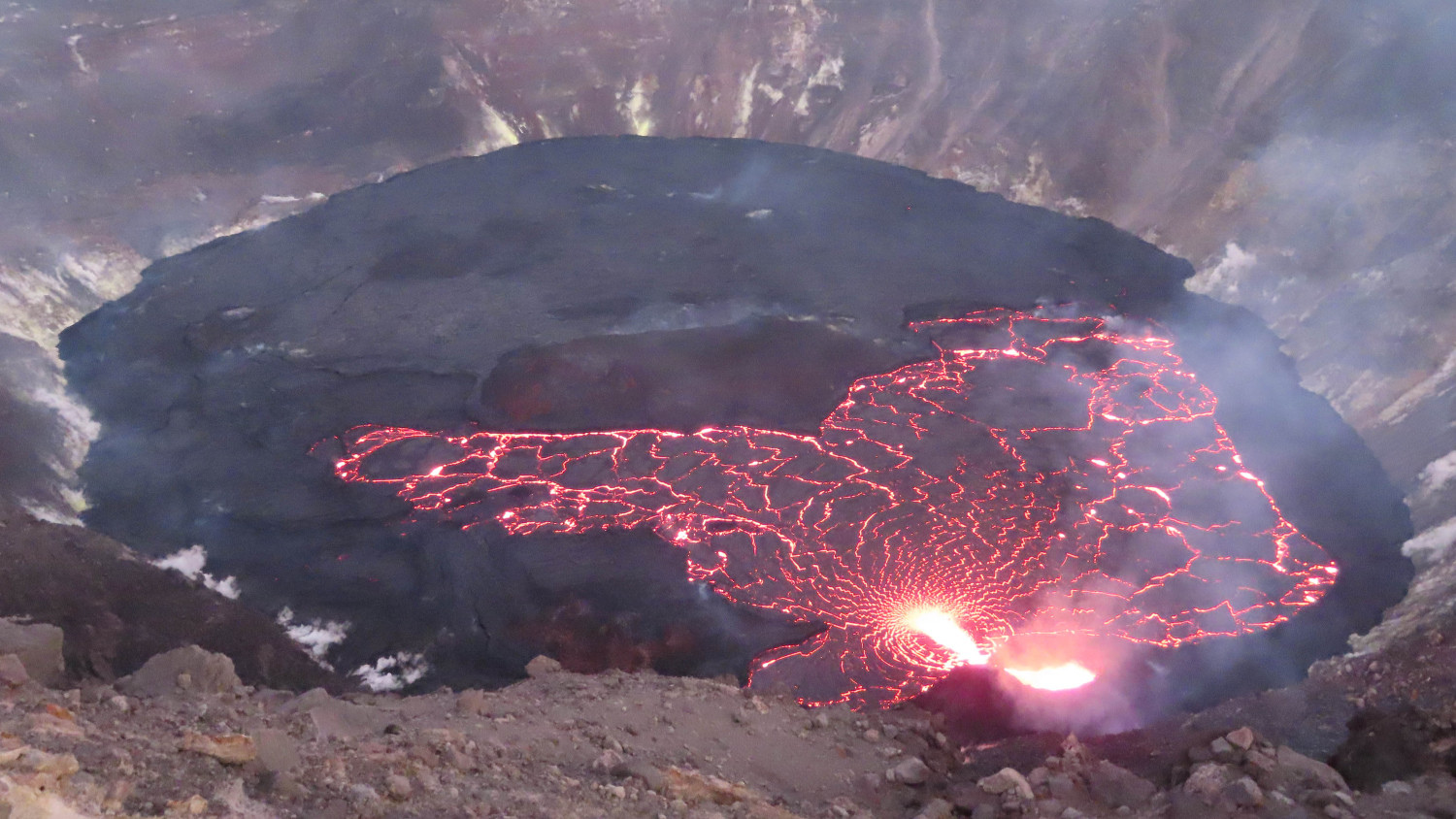
USGS: “A sequence of telephoto images of the west vent (spanning 4 seconds), within Halema‘uma‘u at Kīlauea summit. The west vent continues to produce low-level lava fountains (seen here), which are forming an elevated pond of lava within the spatter cone. The pond then supplies lava to the lava lake through a small spillway that is obscured here by the volcanic gas plume.” (USGS photos taken on November 1, 2021, by N. Deligne)
(BIVN) – Kilauea volcano continues to erupt, with all activity confined to the summit in Halemaʻumaʻu crater within Hawaiʻi Volcanoes National Park.
From the USGS Hawaiian Volcano Observatory update on Thursday:
Summit Observations: Sulfur dioxide (SO2) emission rates remain high, with a preliminary emission rate for October 28, 2021, of at least 3,600 tonnes per day. Summit tilt and GPS observations show no or minimal deformation over the past week. Earthquake activity remains below background and volcanic tremor remains elevated since the beginning of the eruption.
Halemaʻumaʻu Lava Lake Observations: Lava continues to erupt from a single vent in the western wall of Halemaʻumaʻu crater. The western end of the lake showed a maximum elevation of approximately 798.5 meters (2620 ft) above sea level by HVO’s permanent laser rangefinder on November 4, 2021, which is about 0.5 m (1.5 ft) above the previous day, and a total increase of about 55 meters (180 ft) since lava emerged on September 29. The total erupted volume since the beginning of the eruption was estimated to be about 19.9 million cubic meters (5.3 billion gallons) on October 15. Field crews on November 3, 2021 observed roiling and low spattering in the lava pond within the western vent. The short channel leading from the pond within the vent cone into the lava lake is now covered with a cooled crust. The lava lake is not level across its surface due to the location of the vent on the western side. There is about 7 meters (23 feet) elevation difference between the active west and stagnant east part of the lake.
East Rift Zone Observations: No unusual activity has been noted in the Kīlauea East Rift Zone. Ground deformation measurements in the upper East Rift Zone area—between the summit and Puʻuʻōʻo—suggest that refilling of magma since late August, 2021 has slowed or decreased slightly. SO2 and hydrogen sulfide (H2S) emissions from Puʻuʻōʻō were below instrumental detection levels when last measured on January 7, 2021.
Hazard Analysis: This new eruption at Kīlauea’s summit is occurring within a closed area of Hawai’i Volcanoes National Park. Therefore, high levels of volcanic gas are the primary hazard of concern, as this hazard can have far-reaching effects down-wind. Large amounts of volcanic gas—primarily water vapor (H2O), carbon dioxide (CO2), and sulfur dioxide (SO2)—are continuously released during eruptions of Kīlauea Volcano. As SO2 is released from the summit, it reacts in the atmosphere to create the visible haze known as vog (volcanic smog) that has been observed downwind of Kīlauea. Vog creates the potential for airborne health hazards to residents and visitors, damages agricultural crops and other plants, and affects livestock. For more information on gas hazards at the summit of Kīlauea, please see (here). Vog information can be found at vog.ivhhn.org.


by Big Island Video News1:45 pm
on at
STORY SUMMARY
HAWAIʻI VOLCANOES NATIONAL PARK - Kilauea remains at the Volcano Alert Level of WATCH, as lava continues to erupt from a single vent in the western wall of Halemaʻumaʻu crater.